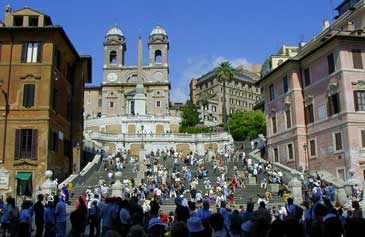 It’s always crowded
It’s always crowded at Piazza di Spagna in Rome, day and night. The name originates from one of the houses by the square, that housed the Spanish embassy in the 17th century. In the 18th century the area was the centre of the hotel district in Rome. The steps were built in 1720 and were immediately crowded with tourists. Today they are the world’s best known, most photographed and visited steps.
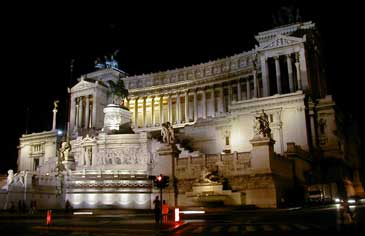 The Victor Emmanuel monument,
The Victor Emmanuel monument, or the ”typewriter” as the inhabitants of Rome call it, is a terrible croquembouche, built during the worst nationalistic era, 1885–1911, to celebrate the king of the same name, who is supposed to have united Italy. Did anyone notice any unity in the country? Anyway, the architecture is best enjoyed at night, and from the other side of the through road.
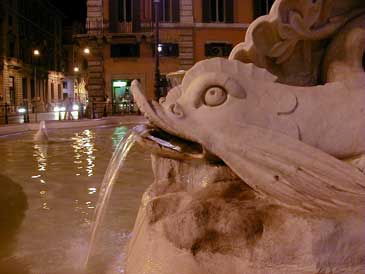 The water in Rome
The water in Rome is excellent; the old aqueducts still survive and the tap water is first-rate. Even the water in the fountains, some of them almost 2000 years old, is drinkable, unless there’s a sign to the contrary. The fountains with gushing water define a lot of the open areas in Rome, and not a few of the street corners. A town without water cannot exist, but few cities have, like Rome, made it a general aspect of the cityscape.
 ”Capitalis Quadrata”
”Capitalis Quadrata” is the name of the typeface that you find on most of the carved inscriptions in Rome. A great number of people believe that the sharp ends on today’s letters come from the carver·s chisel. Before the 2000th anniversary of Rome, Gerhard Unger, a Dutch typeface designer, was given the job of designing a typeface for the town. In 2001 it will be possible to buy the result, Capitolium.
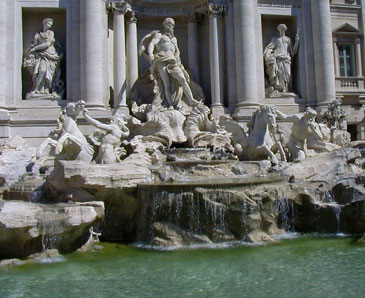 Doesn’t the Trevi fountain
Doesn’t the Trevi fountain look a little naked without Anita Ekberg? The water doesn’t splash as invitingly without a lady in evening dress who adores Neptune and his two Triton-lads. The fountain was built in 1762, Hollywood made it one of the world’s best known places to take a bath 200 years later. But no, you can’t bathe in it. The police watch it day and night, unfortunately. But the policemen have taken the ”tourist course” and are quite nice.
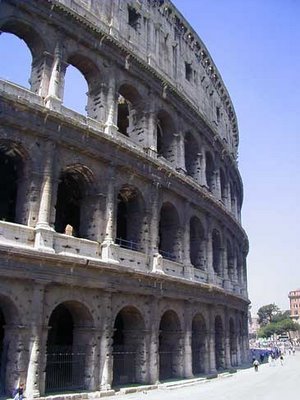 The Colosseum
The Colosseum really is colossal, in the word’s literal sense. Yet very little can be seen of the innovative scenography that made the Colosseum such an attraction at the inauguration in the year 80; 55,000 Romans came, saw, and were impressed. A lot of the things that we take for granted at large sports arenas today can be found in the Colosseum (for example the system of multiple entrances, signs and corridors to help the audience to get to their seats quickly). The shows were sometimes even bloodier than the matches in the Italian league, and the judges could impose worse penalities than a red card.
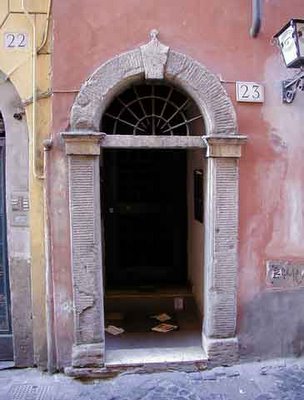 In Trastevere,
In Trastevere, west of the Tiber – the name means ”at the other side of Tevere (Tiber)”, holds some of Rome’s most charming areas. Trastevere is also a neighbour of the Vatican, but the two are very different. Just like Tribeca in New York, Söder in Stockholm, and the Marais in Paris, Trastevere is on its way to being ”upgraded”. Old inhabitants are being pushed out by chic restaurants and clubs, but for the visitor the streets and the houses still seem as genuine as before. The front door shown on this postcard is in Trastevere.
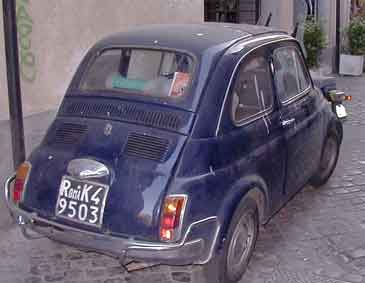 What would Rome be
What would Rome be without the Fiat 500? It’s the only car that has ever been able to force its way though the narrow, winding streets with an open-air café on every sunny corner. Movies that take place in Rome often use a Vespa for transportation. The Fiat 500 is slightly bigger than a Vespa and less comfortable.
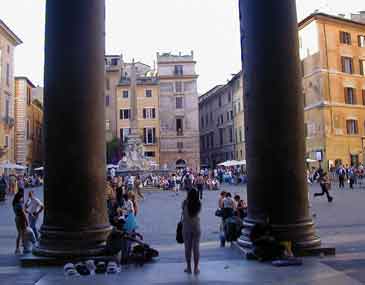 The Pantheon
The Pantheon is situated on the Piazza della Rotonda, and is the best preserved really old building in Rome. The emperor Hadrian (the one with the wall in Great Britain) had it built in 118 AD. In the beginning it was a temple where you could adore any god, but in the 7th century it became a church. The picture is taken from the Pantheon, looking out towards the square.
 It’s always crowded at Piazza di Spagna in Rome, day and night. The name originates from one of the houses by the square, that housed the Spanish embassy in the 17th century. In the 18th century the area was the centre of the hotel district in Rome. The steps were built in 1720 and were immediately crowded with tourists. Today they are the world’s best known, most photographed and visited steps.
It’s always crowded at Piazza di Spagna in Rome, day and night. The name originates from one of the houses by the square, that housed the Spanish embassy in the 17th century. In the 18th century the area was the centre of the hotel district in Rome. The steps were built in 1720 and were immediately crowded with tourists. Today they are the world’s best known, most photographed and visited steps. The Victor Emmanuel monument, or the ”typewriter” as the inhabitants of Rome call it, is a terrible croquembouche, built during the worst nationalistic era, 1885–1911, to celebrate the king of the same name, who is supposed to have united Italy. Did anyone notice any unity in the country? Anyway, the architecture is best enjoyed at night, and from the other side of the through road.
The Victor Emmanuel monument, or the ”typewriter” as the inhabitants of Rome call it, is a terrible croquembouche, built during the worst nationalistic era, 1885–1911, to celebrate the king of the same name, who is supposed to have united Italy. Did anyone notice any unity in the country? Anyway, the architecture is best enjoyed at night, and from the other side of the through road. The water in Rome is excellent; the old aqueducts still survive and the tap water is first-rate. Even the water in the fountains, some of them almost 2000 years old, is drinkable, unless there’s a sign to the contrary. The fountains with gushing water define a lot of the open areas in Rome, and not a few of the street corners. A town without water cannot exist, but few cities have, like Rome, made it a general aspect of the cityscape.
The water in Rome is excellent; the old aqueducts still survive and the tap water is first-rate. Even the water in the fountains, some of them almost 2000 years old, is drinkable, unless there’s a sign to the contrary. The fountains with gushing water define a lot of the open areas in Rome, and not a few of the street corners. A town without water cannot exist, but few cities have, like Rome, made it a general aspect of the cityscape. ”Capitalis Quadrata” is the name of the typeface that you find on most of the carved inscriptions in Rome. A great number of people believe that the sharp ends on today’s letters come from the carver·s chisel. Before the 2000th anniversary of Rome, Gerhard Unger, a Dutch typeface designer, was given the job of designing a typeface for the town. In 2001 it will be possible to buy the result, Capitolium.
”Capitalis Quadrata” is the name of the typeface that you find on most of the carved inscriptions in Rome. A great number of people believe that the sharp ends on today’s letters come from the carver·s chisel. Before the 2000th anniversary of Rome, Gerhard Unger, a Dutch typeface designer, was given the job of designing a typeface for the town. In 2001 it will be possible to buy the result, Capitolium. Doesn’t the Trevi fountain look a little naked without Anita Ekberg? The water doesn’t splash as invitingly without a lady in evening dress who adores Neptune and his two Triton-lads. The fountain was built in 1762, Hollywood made it one of the world’s best known places to take a bath 200 years later. But no, you can’t bathe in it. The police watch it day and night, unfortunately. But the policemen have taken the ”tourist course” and are quite nice.
Doesn’t the Trevi fountain look a little naked without Anita Ekberg? The water doesn’t splash as invitingly without a lady in evening dress who adores Neptune and his two Triton-lads. The fountain was built in 1762, Hollywood made it one of the world’s best known places to take a bath 200 years later. But no, you can’t bathe in it. The police watch it day and night, unfortunately. But the policemen have taken the ”tourist course” and are quite nice. The Colosseum really is colossal, in the word’s literal sense. Yet very little can be seen of the innovative scenography that made the Colosseum such an attraction at the inauguration in the year 80; 55,000 Romans came, saw, and were impressed. A lot of the things that we take for granted at large sports arenas today can be found in the Colosseum (for example the system of multiple entrances, signs and corridors to help the audience to get to their seats quickly). The shows were sometimes even bloodier than the matches in the Italian league, and the judges could impose worse penalities than a red card.
The Colosseum really is colossal, in the word’s literal sense. Yet very little can be seen of the innovative scenography that made the Colosseum such an attraction at the inauguration in the year 80; 55,000 Romans came, saw, and were impressed. A lot of the things that we take for granted at large sports arenas today can be found in the Colosseum (for example the system of multiple entrances, signs and corridors to help the audience to get to their seats quickly). The shows were sometimes even bloodier than the matches in the Italian league, and the judges could impose worse penalities than a red card. In Trastevere, west of the Tiber – the name means ”at the other side of Tevere (Tiber)”, holds some of Rome’s most charming areas. Trastevere is also a neighbour of the Vatican, but the two are very different. Just like Tribeca in New York, Söder in Stockholm, and the Marais in Paris, Trastevere is on its way to being ”upgraded”. Old inhabitants are being pushed out by chic restaurants and clubs, but for the visitor the streets and the houses still seem as genuine as before. The front door shown on this postcard is in Trastevere.
In Trastevere, west of the Tiber – the name means ”at the other side of Tevere (Tiber)”, holds some of Rome’s most charming areas. Trastevere is also a neighbour of the Vatican, but the two are very different. Just like Tribeca in New York, Söder in Stockholm, and the Marais in Paris, Trastevere is on its way to being ”upgraded”. Old inhabitants are being pushed out by chic restaurants and clubs, but for the visitor the streets and the houses still seem as genuine as before. The front door shown on this postcard is in Trastevere. What would Rome be without the Fiat 500? It’s the only car that has ever been able to force its way though the narrow, winding streets with an open-air café on every sunny corner. Movies that take place in Rome often use a Vespa for transportation. The Fiat 500 is slightly bigger than a Vespa and less comfortable.
What would Rome be without the Fiat 500? It’s the only car that has ever been able to force its way though the narrow, winding streets with an open-air café on every sunny corner. Movies that take place in Rome often use a Vespa for transportation. The Fiat 500 is slightly bigger than a Vespa and less comfortable. The Pantheon is situated on the Piazza della Rotonda, and is the best preserved really old building in Rome. The emperor Hadrian (the one with the wall in Great Britain) had it built in 118 AD. In the beginning it was a temple where you could adore any god, but in the 7th century it became a church. The picture is taken from the Pantheon, looking out towards the square.
The Pantheon is situated on the Piazza della Rotonda, and is the best preserved really old building in Rome. The emperor Hadrian (the one with the wall in Great Britain) had it built in 118 AD. In the beginning it was a temple where you could adore any god, but in the 7th century it became a church. The picture is taken from the Pantheon, looking out towards the square.

0 Comments:
Post a Comment
<< Home